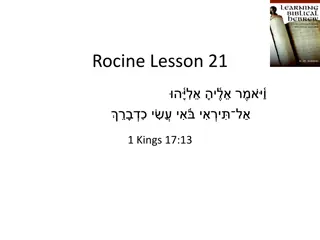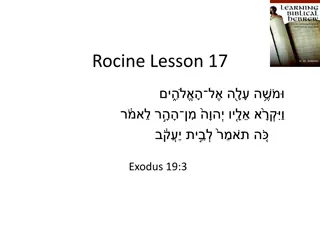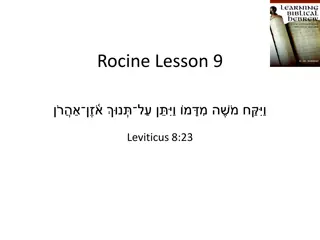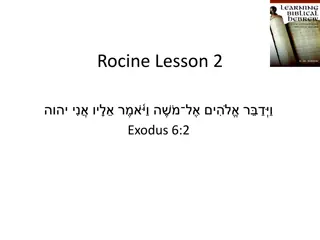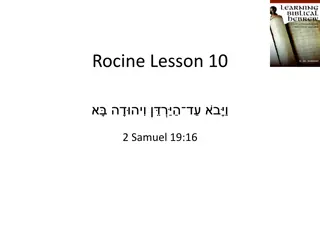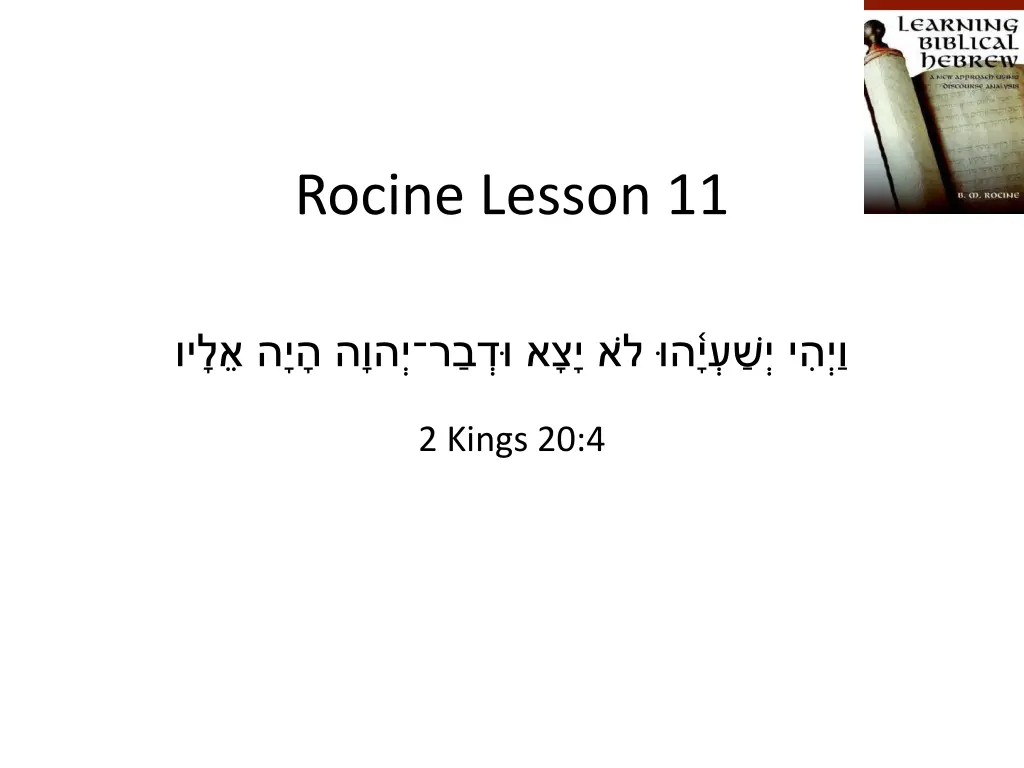
Understanding Historical Narrative Transition Markers in Biblical Hebrew
Explore the significance of Historical Narrative transition markers in Biblical Hebrew, learning how these markers function as both dividers and joiners of text within the context of Hebrew clause construction. Dive into the nuances of wayyiqtol forms and gain insights into identifying clause boundaries and constructing discourse profiles.
Download Presentation

Please find below an Image/Link to download the presentation.
The content on the website is provided AS IS for your information and personal use only. It may not be sold, licensed, or shared on other websites without obtaining consent from the author. If you encounter any issues during the download, it is possible that the publisher has removed the file from their server.
You are allowed to download the files provided on this website for personal or commercial use, subject to the condition that they are used lawfully. All files are the property of their respective owners.
The content on the website is provided AS IS for your information and personal use only. It may not be sold, licensed, or shared on other websites without obtaining consent from the author.
E N D
Presentation Transcript
Rocine Lesson 11 2 Kings 20:4
Goals 1. Identify and read the Historical Narrative transition marker 2. Identify and read irrealis comments constructed with 3. Begin constructing a discourse profile scheme for Historical Narrative 4. Use an understanding of Hebrew clause construction to help identify clause boundaries
What we already know We know how to parse the last verb. Root Stem Form PGN Function Root meaning
What we already know We know how to parse the last verb. Root Stem Form PGN Function Root meaning X-qatal = topicalization To be, become Qal Qatal 3ms
What we already know How could we translate the last clause?
What we already know How could we translate the last clause? And it was the word of YHWH which came to him
Historical Narrative transition marker RULE: The word has a special function in Biblical Hebrew as a transition marker.
Historical Narrative transition marker RULE: The word has a special function in Biblical Hebrew as a transition marker. Wayyiqtol form of Basic meaning to happen, become, be Like the verb to be in English But often has the added nuance of something happening, not just being
Historical Narrative transition marker It is simultaneously a divider and joiner of text Divider: marks the onset of a new scene a new episode the entrance of a new participant in a story. Joiner: At the same time it does indeed join the scene or episode it marks to a larger discourse.
Historical Narrative transition marker The nikkud is irregular learn without analysis, i.e. as a sight word Very common, occurs 700+ times in HB Translation: And (then) it happened orleft untranslated Function (in analysis chart): transition marker
Historical Narrative transition marker Looks like a Piel but it s Qal. The nikkud is irregular, learn without analysis, i.e. as a sight word Very common, occurs 700+ times in HB Translation: And (then) it happened orleft untranslated Function (in analysis chart): transition marker Triply weak. Heh, Yod, Heh
Historical Narrative transition marker Looks like a Piel but it s Qal. The nikkud is irregular, learn without analysis, i.e. as a sight word Very common, occurs 700+ times in HB Translation: And (then) it happened orleft untranslated Function (in analysis chart): transition marker Triply weak. Heh, Yod, Heh Root Stem Form PGN Function Root meaning
Historical Narrative transition marker Looks like a Piel but it s Qal. The nikkud is irregular, learn without analysis, i.e. as a sight word Very common, occurs 700+ times in HB Translation: And (then) it happened orleft untranslated Function (in analysis chart): transition marker Triply weak. Heh, Yod, Heh Root Stem Form PGN Function Root meaning To be, become Qal Wayyiqtol 3ms Transition Marker
Historical Narrative transition marker Nota Bene: Even though is a wayyiqtol and the genre is Historical Narrative, it is off-line, not mainline. It is off-line because it is not describing the next event in the narrative. Root Stem Form PGN Function Root meaning Transition Marker (off-the-line) To be, become Qal Wayyiqtol 3ms
Next three words In the next 3 words we have an X-qatal. Identify the X Identify the qatal How is the X related to the qatal?
Next three words In the next 3 words we have an X-qatal. Identify the X Identify the qatal How is the X related to the qatal? (Isaiah) (Isaiah) is the subject of the qatal
Irrealis means no, not
Irrealis means no, not converts a verb to irrealis i.e. a statement of what is not rather than what is
Irrealis means no, not converts a verb to irrealis i.e. a statement of what is not rather than what is Do not confuse and ( to him or his )
Irrealis Translate the elements.
Irrealis he went out not Isaiah and it happened
Irrealis he went out not Isaiah and it happened X-qatal
Irrealis he went out not Isaiah and it happened X-qatal It was Isaiah who was not a goer forth It was Isaiah who did not go out
Irrealis he went out not Isaiah and it happened X-qatal It was Isaiah who was not a goer forth It was Isaiah who did not go out Translation of first clause: And it happened that it was Isaiah who was not a goer forth / did not go out Or simply It was Isaiah who was not a goer forth / did not go out The transition marker is often left untranslated in English.
Irrealis he went out not Isaiah and it happened X-qatal It was Isaiah who was not a goer forth It was Isaiah who did not go out RULE: The conversion of any verb to irrealis, that is, a statement of what is not rather than what is, by the word moves the verb form to the lowest place in the discourse profile scheme of a genre.
Discourse profile A bit of review What is a discourse? What is a genre?
Discourse profile A bit of review A Discourse: a self-contained text, maybe long or maybe short, but the text has its own plan, purpose, and meaning. Genre: A kind of discourse E.g. Historical Narrative Tell a story about the past. Predictive Narrative Tell a story set in the future. Instructional Discourse Tell how to do something. Hortatory Discourse Influence the behavior of someone. Procedural Discourse Tell how a procedure was done in the past.
Discourse profile A bit of review A Discourse: a self-contained text, maybe long or maybe short, but the text has its own plan, purpose, and meaning. Genre: A kind of discourse E.g. Historical Narrative Tell a story about the past. Predictive Narrative Tell a story set in the future. Instructional Discourse Tell how to do something. Hortatory Discourse Influence the behavior of someone. Procedural Discourse Tell how a procedure was done in the past.
Discourse profile A bit of review A Discourse: a self-contained text, maybe long or maybe short, but the text has its own plan, purpose, and meaning. Genre: A kind of discourse E.g. Historical Narrative Tell a story about the past. Predictive Narrative Tell a story set in the future. Instructional Discourse Tell how to do something. Hortatory Discourse Influence the behavior of someone. Procedural Discourse Tell how a procedure was done in the past. Today we are looking at the discourse profile of the historical narrative genre. The profile is how the discourse of this particular genre is structured.
Discourse profile The idea is that the mainline verb form is like the skeleton from which hang all the tissue of detail, setting, summary, and elaboration. All off-the-line verb forms in a genre provide these details, settings, summaries, and elaborations as they retard the forward progress of the mainline. The lower a verb form is in the profile, the farther away it is from the mainline and the more it tends to retard the forward progress of the mainline.
Discourse profile 1. Mainline: Wayyiqtol Off-the-line: 2. Topicalization: X-qatal 3. Relative past background: qatal 4. Transition marker: Wayyiqtol of 5. Scene setting: Verbless Clause 6. Irrealis scene setting: Negation of any verb by
Discourse profile 1. Mainline: Wayyiqtol (Lesson 1, p 4) Off-the-line: 2. Topicalization: X-qatal 3. Relative past background: qatal 4. Transition marker: Wayyiqtol of 5. Scene setting: Verbless Clause 6. Irrealis scene setting: Negation of any verb by (Lesson 5, p 23) (Lesson 4, p 18) (Lesson 11, p 51) (Lesson 2, p 10) (Lesson 11, p 52)
Discourse profile 1. Mainline: Wayyiqtol Skeleton or Framework Off-the-line: 2. Topicalization: X-qatal 3. Relative past background: qatal 4. Transition marker: Wayyiqtol of 5. Scene setting: Verbless Clause 6. Irrealis scene setting: Negation of any verb by Details: setting, summary, elaboration, etc.
Discourse profile Advances the narrative 1. Mainline: Wayyiqtol Skeleton or Framework Off-the-line: 2. Topicalization: X-qatal 3. Relative past background: qatal 4. Transition marker: Wayyiqtol of 5. Scene setting: Verbless Clause 6. Irrealis scene setting: Negation of any verb by Details: setting, summary, elaboration, etc.
Discourse profile Dynamic action Advances the narrative 1. Mainline: Wayyiqtol Skeleton or Framework Off-the-line: 2. Topicalization: X-qatal 3. Relative past background: qatal 4. Transition marker: Wayyiqtol of 5. Scene setting: Verbless Clause 6. Irrealis scene setting: Negation of any verb by Details: setting, summary, elaboration, etc.
Discourse profile Dynamic action Advances the narrative 1. Mainline: Wayyiqtol Skeleton or Framework Off-the-line: 2. Topicalization: X-qatal 3. Relative past background: qatal 4. Transition marker: Wayyiqtol of 5. Scene setting: Verbless Clause 6. Irrealis scene setting: Negation of any verb by Details: setting, summary, elaboration, etc. Note: This is not a ranking of importance. It is a ranking of movement in the narrative the lower the rank the more that construction slows the forward progress of the discourse. Sometimes off-line constructions contain the most important material: like a slow-mo section of a video or even a freeze frame .
Identifying where clauses begin and end This is an art Look for the waws, that will tell you an awful lot Read Rocine s section on this (11.5) but it s best dealt with when looking at the concrete examples in the exercises

